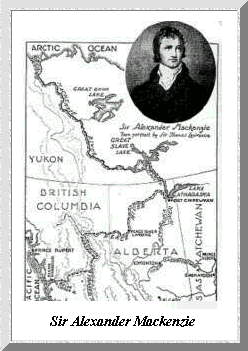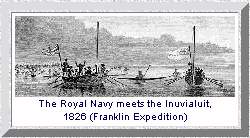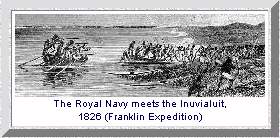


... To 1902 - European Explorers
The first European to visit the land of the Inuvialuit was the Scottish fur trader and explorer Alexander Mackenzie, who in 1789 journeyed down the Mackenzie River to the  sea. His Dene Indian guides were careful that they not meet any Inuvialuit, though he did see some abandoned camps. Dene and Inuvialuit were traditional enemies, and once in Inuvialuit lands (which traditionally began at Point Separation at the upper end of the Mackenzie Delta), his guides became very cautious, steering Mackenzie clear of the well populated East Channel of the river, toward the maze of the middle delta.
sea. His Dene Indian guides were careful that they not meet any Inuvialuit, though he did see some abandoned camps. Dene and Inuvialuit were traditional enemies, and once in Inuvialuit lands (which traditionally began at Point Separation at the upper end of the Mackenzie Delta), his guides became very cautious, steering Mackenzie clear of the well populated East Channel of the river, toward the maze of the middle delta.

In 1826 the British Royal Navy, intent upon a Northwest Passage, sent a party under the command of Lt. John Franklin down the Mackenzie River. At Point Separation they split into two parties. One, under Franklin himself, took the West Channel of the river to Shallow Bay, and then coasted west in an attempt to reach Point Barrow. The second party, under Dr. John Richardson, took the East Channel, and then travelled east to the Coppermine River. Both encountered a fairly hostile reception from Inuvialuit, and avoided bloodshed (and possible massacre) only with considerable difficulty. We owe our earliest detailed written descriptions of the Inuvialuit to this second Franklin expedition, and especially to Richardson, who was an intelligent and sometimes sympathetic observer.

The next flurry of exploration in the area was a consequence of the third Franklin expedition, launched in 1845 and considered missing by 1848. John Richardson returned to the western Arctic in a vain search for his former commander, descending the Mackenzie River and travelling east again to the Coppermine. He was followed by captains M'Clure, Pullen, and McClintock, all of whom met Inuvialuit and left published journals. By the early 1850s, the Inuvialuit coast lines were well explored (although the existence of the Eskimo Lakes was still hotly debated) and radical cultural change was just over the horizon.

[Opening Page | The Land | The People | From Ancient Times | ...to 1902 | Survival |About the Researcher]